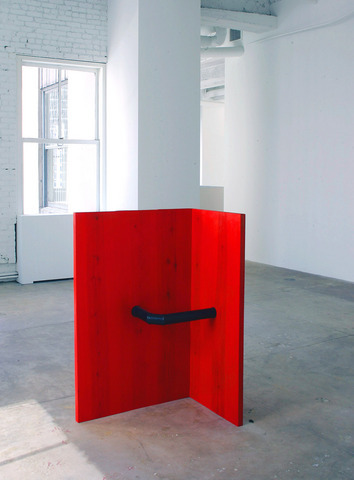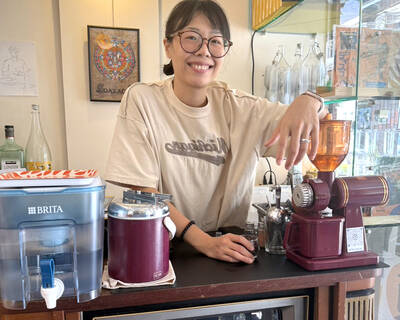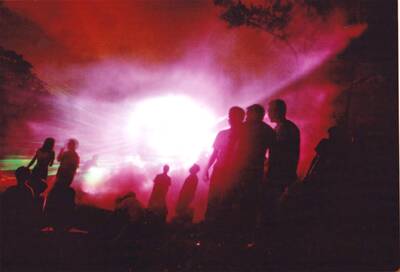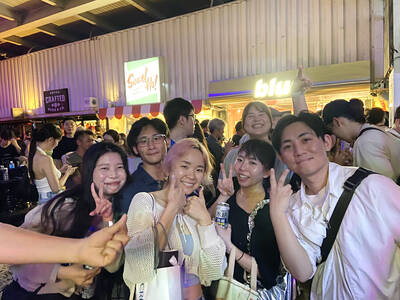For the next two weeks, New York has something it may never have again: a small, unpretentious single-artist museum devoted to the achievements of the minimalist sculptor Donald Judd.
This museum has been rather hastily assembled by an unlikely entity: Christie's New York.
Its unlikely setting is two floors atop the Simon & Schuster Building, 1230 Avenue of the Americas in Midtown Manhattan, around the corner from the auction house at Rockefeller Center.

PHOTO: NY TIMES NEWS SERVICE
The show is, in fact, the presale exhibition of 35 Judd works offered for sale by the Judd Foundation, established by the artist's estate in 1996, two years after his death. Everything on view is to be sold to the highest bidder on the final day of the show.
The works, which date from around 1970 to 1993, form a haphazard, partial and sometimes redundant survey of Judd's sculpture. They are clearly pieces that the foundation, which is in dire economic straits, has decided it can do without.
So I'm as surprised to be writing the following as you may be to read it: This exhibition is the most beautiful survey of Judd's work ever seen in New York, and the first to be displayed under conditions of space and light that the famously demanding artist might have found satisfactory. Christie's has made an unusual effort with this display, stripping the light-flooded space -- there are windows on four sides -- to its bare-bones cement surfaces. Judd's son, Flavin, who has some of his father's sense of proportion, had a role in planning both the raw-looking interior and the spare installation. And in the end the pieces work fairly well together, illustrating Judd's thinking about the box -- the basic of unit of his art -- as it moves between wall and floor, and from single-unit to multi-part pieces.
The conditions of the sale have been reported. Christie's is said to have guaranteed the foundation around US$20 million, which it needs to pay off debts and establish an endowment; maintain the 16 buildings it owns in New York and in Marfa, Texas; conserve the collections and library amassed by Judd; catalog his archives; and start converting his extensive unpublished writings into book form. His legacy, as complex physically as it is intellectually, is a national treasure that should be much more accessible to the public.
It has been argued that this sale, in releasing so many works at one time, could deflate the Judd market and that a slower, private, more dignified weeding process would have permitted more pieces to be placed in public collections.
Yet Judd might have viewed the sale with a certain pragmatic equanimity. I worked for him briefly in the early 1970s, mostly on his catalog raisonne. He remarked more than once that one purpose of his smaller, portable sculptures was to make money to pay for larger projects.
The foundation Judd mandated in his will is a very large project. He might even have liked the bold gesture of one big, widely publicized get-it-over-with auction. Besides, he famously hated museums, especially American ones.
Questions will always remain about whether the foundation exhausted all fundraising possibilities before setting this course. And only time will tell if the influx of money can solve problems that may be more than simply financial. Adding peripheral heat to the discussion is the spectacle of Christie's promoting this presale show as the largest exhibition of Judd's work in this country since 1988, the year of his second retrospective at the Whitney Museum of American Art.
First auction houses supersede galleries, then they move in on museums? Christie's has even provided an Acoustiguide.
Christie's has indeed behaved like a museum -- or at least in a way more museums should act. Basically, it has put art before architecture in an uncluttered display that makes the work optimally visible. The presentation is undoubtedly a fantastic sales tool, but it is also a temporary gift to the city, one that every museum professional should see.
Judd went to Marfa because he found the conditions under which New York museums displayed contemporary art to be deplorable. His point remains a good one: Art cannot be fully understood if it is not fully experienced. And if not fully experienced, it cannot meet one of its chief responsibilities: to give subsequent gener-ations of artists something to build on. Looking at the Christie's show, New York can finally see what Judd meant. It makes his case with his art, on his home turf, in the city that nurtured his genius.
Artists' museums -- the Rodin Museum in Paris, for example -- are rarely complete or packed with masterpieces. Yet their exclusive focus provides an organic, undiluted sense of an artist's basic operating principles, and that is what happens at Christie's.
The quantities of natural light and space here, as in Judd's Marfa displays, bring into sharp focus the way he combined the opposing modernist forces of Matisse and Duchamp -- art and anti-art, full-on retinal seduction and the cerebral provocation of the ready-made. Light makes his colors sing and also brings out the differences in his basic ready-made materials: metal, Plexiglas and plywood. Compare the amber color of an anodized aluminum wall stack, for example, with the glowing Plexiglas that surprises you at the bottom of a large floor box.
And like all artist's museums, this exhibition includes some unexpected quirks. One is a 1993 plain plywood wall piece, based on a 1961 red relief with a found-object brass circle at its center; here the circle is simply a hole exposing more plywood.
This piece almost makes a kind of joke of Judd's continued emphasis on a work's structural honesty, a concept he was continually tweaking. In 1988, he remade one of his first free-standing pieces -- an upright red right angle made of two slabs of wood with a found piece of right-angle pipe connecting their center points. The original was painted red, the second is stained red, allowing the (considerably fancier) grain to show. Judd also "stained" plywood with transparent colored Plexiglass, as in a beautiful late wall stack of small boxes that is on view in the lobby at Christie's. The interior back plane of each box is a different color.
In some ways, this show may be more satisfying than visiting Marfa. Here, the art is unencumbered by all the Juddian trappings: the real estate, the collections, the lifestyle and the sense of the artist as proud possessor and reigning deity. It demonstrates how unfancy and basic a space can be and yet make art look really, really good.

Cheng Ching-hsiang (鄭青祥) turned a small triangle of concrete jammed between two old shops into a cool little bar called 9dimension. In front of the shop, a steampunk-like structure was welded by himself to serve as a booth where he prepares cocktails. “Yancheng used to be just old people,” he says, “but now young people are coming and creating the New Yancheng.” Around the corner, Yu Hsiu-jao (饒毓琇), opened Tiny Cafe. True to its name, it is the size of a cupboard and serves cold-brewed coffee. “Small shops are so special and have personality,” she says, “people come to Yancheng to find such treasures.” She

Late last month Philippines Foreign Affairs Secretary Theresa Lazaro told the Philippine Senate that the nation has sufficient funds to evacuate the nearly 170,000 Filipino residents in Taiwan, 84 percent of whom are migrant workers, in the event of war. Agencies have been exploring evacuation scenarios since early this year, she said. She also observed that since the Philippines has only limited ships, the government is consulting security agencies for alternatives. Filipinos are a distant third in overall migrant worker population. Indonesia has over 248,000 workers, followed by roughly 240,000 Vietnamese. It should be noted that there are another 170,000

In July of 1995, a group of local DJs began posting an event flyer around Taipei. It was cheaply photocopied and nearly all in English, with a hand-drawn map on the back and, on the front, a big red hand print alongside one prominent line of text, “Finally… THE PARTY.” The map led to a remote floodplain in Taipei County (now New Taipei City) just across the Tamsui River from Taipei. The organizers got permission from no one. They just drove up in a blue Taiwanese pickup truck, set up a generator, two speakers, two turntables and a mixer. They

Hannah Liao (廖宸萱) recalls the harassment she experienced on dating apps, an experience that left her frightened and disgusted. “I’ve tried some voice-based dating apps,” the 30-year-old says. “Right away, some guys would say things like, ‘Wanna talk dirty?’ or ‘Wanna suck my d**k?’” she says. Liao’s story is not unique. Ministry of Health and Welfare statistics show a more than 50 percent rise in sexual assault cases related to online encounters over the past five years. In 2023 alone, women comprised 7,698 of the 9,413 reported victims. Faced with a dating landscape that can feel more predatory than promising, many in